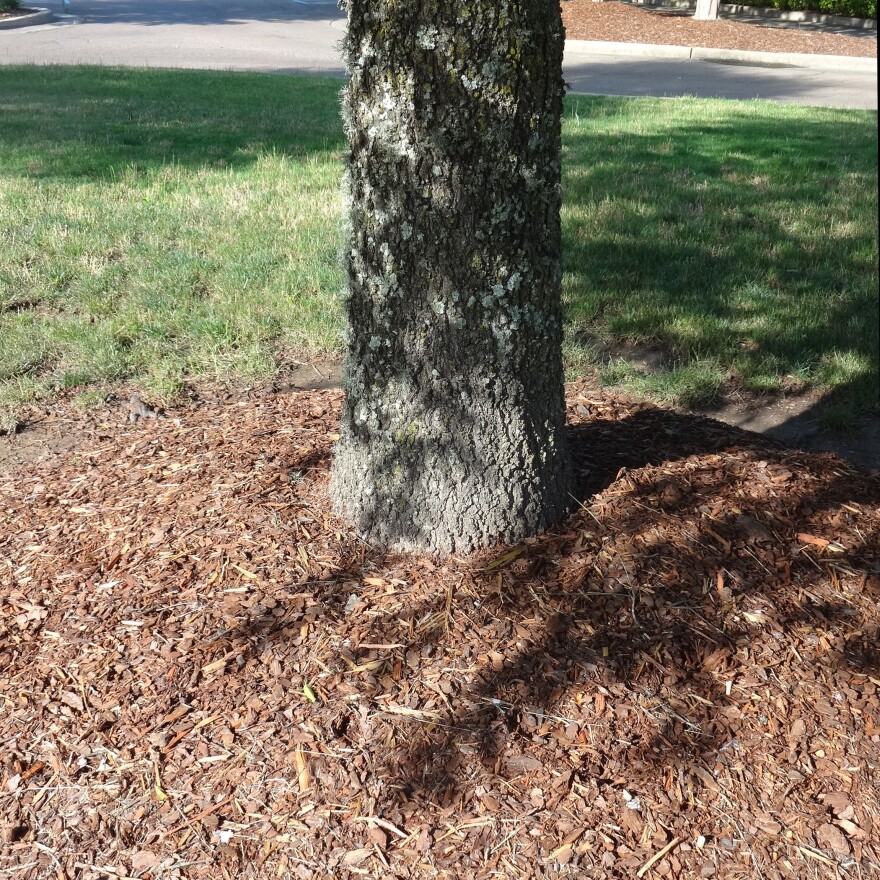Mowers and string trimmers that use a monofilament line for cutting down weeds and grass can be very damaging to young trees. Young trees have relatively thin bark. If the line is allowed to hit the trunk part of the bark will be removed with east contact of the line.
If you are not careful, you might even remove an entire ring of bark all the way around the trunk, girdling the tree. Mowers pushed hard or dragged around the base of young trees can be almost as damaging.
The part of a tree's circulatory system that carries food manufactured by the leaves to the roots (which can make no food for themselves) lies just under the bark. Damage that occurs when mowers or string trimmers remove patches of bark interferes with the tree's ability to send food to its roots. As the roots are deprived of food they become stunted and function poorly, and this leads to a stunted, unhealthy tree. Remove a complete ring of bark and you may cut off food to the roots altogether, leading to the death of the plant.
In addition interfering with food movement, the open wounds created by mowers and trimmers can provide entry points for disease organisms that can cause decay.
Many sickly, stunted trees that have been planted for years but don't grow well have been damaged in this way. Look at the base of their trunks and you will often see scars and callus growth from repeated injury done to the base of the tree.
To prevent these problems, do not allow grass to grow close to the base of young trees for the first three to five years after planting. Keep an area at least a foot out from the trunk grass free. A mulch two or three inches thick spread evenly over the area, but pulled back slightly from the trunk, will help a lot. Any stray weeds can be pulled or killed with a quick spray of glyphosate, if necessary.
Shrubs are generally planted in beds so are less at risk. But I have seen this problem occasionally when ground covers, such as Asiatic jasmine, are trimmed away from the base of the shrubs with string trimmers. Whether you maintain your landscape yourself or pay someone to do it for you, don't let this kind of needless damage happen to your tree and shrubs.
Trees are also vulnerable to root damage from construction and/or filling. If you plan on doing construction, whether building a new home, adding on to an existing one or even putting in a patio or repairing driveways or sidewalks, tree roots will likely be an issue.
Tree roots extend well beyond the reach of the branches, and the majority of the feeder roots (those that absorb the water and minerals from the soil) are located in the upper 8 to 12 inches of the soil. This makes them much more vulnerable to damage than most people appreciate. Tree roots are not expendable. They are the only way a tree can drink the water it needs and they hold out trees up during the high winds of hurricanes.
Another way gardeners damage landscape plants is the improper use of pesticides and fertilizers. These products are useful and sometimes necessary to maintaining a healthy attractive landscape, but if misused can do more harm than good.
You can avoid damaging plants with pesticides, such as insecticides, herbicides and fungicides, by carefully reading and following label directions. I know the print can be very fine, but do like me and get out the magnifying glass if you need to. Read the label completely right at the nursery before you purchase the product. This will give you a chance to ask any questions you might have about using the product while the staff is there to help you.
Many people also damage plants with fertilizers or plant food. Gardeners often think if a little is good, more is even better. But, fertilizers should never be applied stronger than label recommendations. You may apply less than is recommended, but mixing fertilizer stronger or applying more than is recommended on the label can lead to serious damage to your plant.



